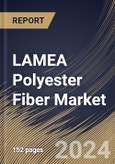Integrating technology with textiles is a burgeoning trend in the industry, and polyester fibers are at the forefront of this innovation. Smart textiles, including functionalities such as temperature regulation, moisture management, and electronic components, are gaining popularity. Polyester's compatibility with advanced technologies positions it as a key player in developing smart and functional textiles for diverse applications, including healthcare, sports, and military sectors.
The demand for customized and personalized products drives a trend toward developing specialty polyester fibers. Manufacturers are focusing on creating fibers with specific attributes, such as enhanced softness, anti-microbial properties, or unique textures, catering to the discerning preferences of consumers. The e-commerce industry's exponential growth directly impacts the market, particularly in the packaging segment. With the rise of online retail, there is an increased demand for durable and protective packaging materials. With their strength and flexibility, polyester fibers are well-suited for meeting the packaging needs of the booming e-commerce sector.
The UAE hosts international fashion events and exhibitions, showcasing the latest trends and designs. The expansion of retail outlets and the growth of e-commerce in the UAE have increased access to a wide range of clothing items. Polyester fibers, used in packaging and apparel sold online and in stores, benefit from the surge in retail activities. While often associated with affordable fashion, polyester fibers are also used to produce luxury fashion items. The adaptability of polyester allows for the creation of high-quality, luxurious textiles. As a result, these aspects will boost the market growth in the coming years.
The Brazil market dominated the LAMEA Polyester Fiber Market, By Country in 2022, and would continue to be a dominant market till 2030; thereby, achieving a market value of $3,403.1 million by 2030. The Argentina market is showcasing a CAGR of 10.3% during (2023 - 2030). Additionally, The UAE market would register a CAGR of 8.8% during (2023 - 2030).
Based on Form, the market is segmented into Solid, and Hollow. Based on Grade, the market is segmented into PET Polyester, and PCDT Polyester. Based on Product Type, the market is segmented into Polyester Staple Fiber (PSF), and Polyester Filament Yarn (PFY). Based on Application, the market is segmented into Textile & Apparel, Automotive & Transportation, Home Furnishing, Industrial, and Others. Based on countries, the market is segmented into Brazil, Argentina, UAE, Saudi Arabia, South Africa, Nigeria, and Rest of LAMEA.
List of Key Companies Profiled
- Reliance Industries Limited
- Toray Industries, Inc.
- Sinopec Group (China Petrochemical Corporation)
- The Bombay Dyeing & Manufacturing Company Ltd. (Wadia Group)
- Indorama Ventures Public Company Limited (Indorama Resources Ltd.)
- Green Group SA.
- W.R. Grace & Co. (Standard Industries)
- Markische Faser GmbH
- Stein Fibers Ltd.
- Nan Ya Plastics Corp. (NPC)
Market Report Segmentation
By Form (Volume, Kilo Tonnes, USD Billion, 2019-2030)- Solid
- Hollow
- PET Polyester
- PCDT Polyester
- Polyester Staple Fiber (PSF)
- Polyester Filament Yarn (PFY)
- Textile & Apparel
- Automotive & Transportation
- Home Furnishing
- Industrial
- Others
- Brazil
- Argentina
- UAE
- Saudi Arabia
- South Africa
- Nigeria
- Rest of LAMEA
Table of Contents
Companies Mentioned
- Reliance Industries Limited
- Toray Industries, Inc.
- Sinopec Group (China Petrochemical Corporation)
- The Bombay Dyeing & Manufacturing Company Ltd. (Wadia Group)
- Indorama Ventures Public Company Limited (Indorama Resources Ltd.)
- Green Group SA.
- W. R. Grace & Co. (Standard Industries)
- Markische Faser GmbH
- Stein Fibers Ltd.
- Nan Ya Plastics Corp. (NPC)
Methodology

LOADING...








